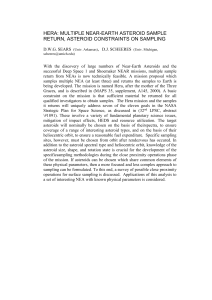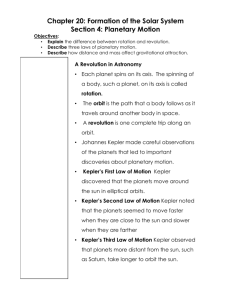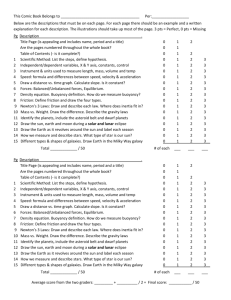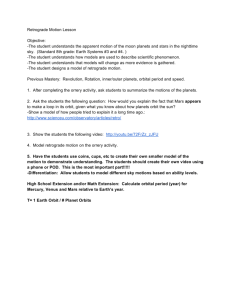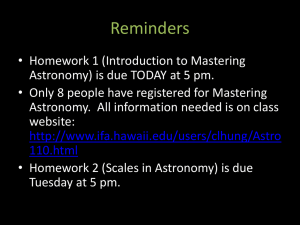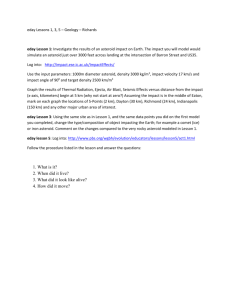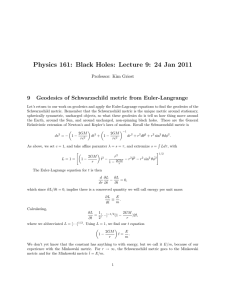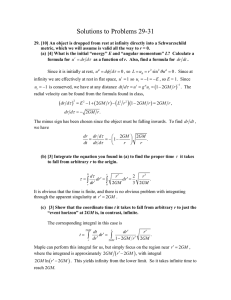Lecture 23 - LSU Physics & Astronomy
advertisement
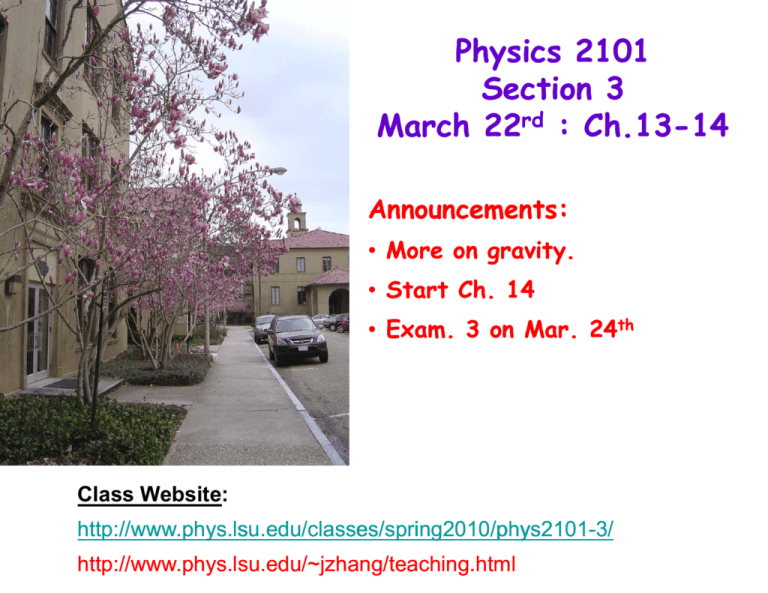
Physics 2101 Section 3 Ch.13-14 March 22rd : Ch.13Announcements: • More on gravity. • Start Ch. 14 • Exam. 3 on Mar. 24th Class Website: http://www.phys.lsu.edu/classes/spring2010/phys2101--3/ http://www.phys.lsu.edu/classes/spring2010/phys2101 http://www.phys.lsu.edu/~jzhang/teaching.html Chapt.. 13: review Chapt Force on 1 due to 2: m1m2 F12 = G 2 rˆ12 r12 G = 6.67 ×10−11 N ⋅ m 2 / kg 2 n Force on 1 due to many: F1,net = F12 + F13 + F14 + ...+ F1n = ∑ F1i VECTOR ADDITION!! i=1 Gravitational potential energy If we define U = 0 at ∞, then the work done by taking mass m from R to ∞ m1m2 U(r)) = −G U( G r12 m1m2 F12 = G 2 rˆ12 r12 Planets and Satellites: Kepler’s Laws Kepler Brahe 1571-1630 1546-1601 Newton 1642-1727 1) Law of Orbits: All planets move in elliptical orbits with the Sun at one focus Ellipse criterion: Fm + F’m = const a = semimajor axis e = eccentricity Assumes MSun >> ME sun-earth sun earth farthest point Ra = aphelion closest point Rp = perihelion Ra = a(1+ e) Rp = a(1− e) earth-moon earth moon = apogee = perigee Planets and Satellites: Kepler’s 2nd Law 2)) Law of equal q areas : A line that connects a planet to the sun sweeps out equal areas in equal time - Planets move slowest when furthest away from Sun (at Ra) - Planets Pl t move fastest f t t when h closest l t away from f Sun S (at ( t Rp) ANGULAR MOMENTUM IS CONSERVED Angular momentum L =r ×p L = rp = r (mv) = r (m(ωr)) = mr 2ω L = r 2ω m Area of “triangle”: dA = 12 ( rdθ ) r dA 1 2 dθ 1 2 = 2r = 2r ω dt dt dA L = = constant dt 2m Planets and Satellites: Kepler’s 3rd Law 3) The Law of Periods : The square of the period of any planet is proportional to the cube of the semimajor axis of its orbit ⎛ 2πrsat ⎞ ⎜ ⎟ Gmsat M E ⎝ T ⎠ − = −msat 2 rsat rsat 2 ⎛ GM ⎞ 2 ⇒ r =⎜ T 2 ⎟ ⎝ 4π ⎠ ⎛ 4π 2 ⎞ ⇒ T2 =⎜ ⎟rsat3 ⎝ GM ⎠ 3 sat NOTE: r3 ∝ T2 Elliptical Orbit Circular Orbit When used in the equations, r (radius) and a ((semimajor semimajor axis) are synonymous Example: Hot Jupiter In 2004 astronomers reported the discovery of a large Jupiter-sized planet orbiting very close the star HD 179949 179949. The orbit was as abo aboutt 1/9 the distance of Mercury Merc r from our o r sun, s n and it takes the planet only 1.09 days to make one orbit (assumed to be circular). (a) What is the mass of the star? (b) How fast is this planet moving? 2π r 3/ 2 1 5 = 2.67 ×10 s and r = rMercury = 6.43 ×109 m a) T = 9 GM star M star 4π 2 r 3 = 2 = 2.21×1030 kg = 1.11M Sun T G 2π r b) v = = 1.51×105 m/s T Conservation of Mechanical Energy Escape speed: Minimum speed (vexcape) required to send a mass m, from mass M and position R, to infinity, while coming to rest at infinity. At infinity: y Emech= 0 because U = 0 and KE = 0 Thus any other place we have: E mech ⎛ 1 2 GmM ⎞ ⇒ E = = (KE + U g ) = 0 ⎜ mv − ⎟ = 0 ⇒ vescape = mech ⎝2 R ⎠ Escape speed: 2GM R Earth = 11.2 km/s ((25,000 , mi/hr)) Moon = 2.38 km/s Sun = 618 km/s Problem 13-37 a) What is the escape speed on a spherical asteroid whose radius is 500 km and whose gravitational acceleration at the surface is is 3 m/s2 ? b) How far from the surface will the particle go if it leaves the asteroid’s surface with a radial speed of 1000 m/s? c) With what speed will an object hit the asteroid if it is dropped from 1000 km above the surface? Problem 13-37 a) What is the escape speed on a spherical asteroid whose radius is 500 km and whose gravitational acceleration at the surface is is 3 m/s2 ? b) H How ffar ffrom th the surface f will ill the th particle ti l go if it leaves l the th asteroid’s t id’ surface f with ith a radial di l speedd off 1000 m/s? c) With what speed will an object hit the asteroid if it is dropped from 1000 km above the surface? ag R 2 GM 2 a) a g = 2 =3 m/s ; M = R G 2GM 2GM v= = = 2ag R = 1.732 ×103 m/s R R b) Mechanical energy consevation: Rf = 1 2 mM mM =-G mvi -G 2 Ri Rf 2GM = 2.5 ×105 m/s 2GM − vi2 Ri c) Mechanical energy consevation: − G mM mM 1 2 = −G + mv f Ri Rf 2 1 2 1 1 1 1 v f = GM ( − ) ⇒ v f = 2GM ( − ) = 1.4 km/s 2 Ri R f Ri R f Why v f ≠ 2ag h = 2ag ( Ri − R f ) ? Chapter 14: Fluids What is a fluid?? S lid vs liquids Solids li id vs gasses Pressure F P≡ A “collisional collisional force force” Units: pascal = Pa = N/m2 1 atmosphere = 1 atm = 1.01×105 Pa = 760 torr = 14.7 lb/in2 The collisions of gas molecules on the wall of the tire keep it inflated Uniform ⊥ force on flat area Hydrostatic Pressure: Water applies a force perpendicular to all of the surfaces in the pool, including the swimmer, the walls of the pool etc. Density m ρ≡ V Note: density solid > liquid > gas air = wood = water = Al = Cu = Pb = 1.21 kg/m3 550 kg/m3 1000 kg/m3 2700 kg/m3 = 2.7 g/cm3 8960 kg/m3 = 8.9 g/cm3 11340kg/m3 = 11.34 g/cm3 “Vacuum”

